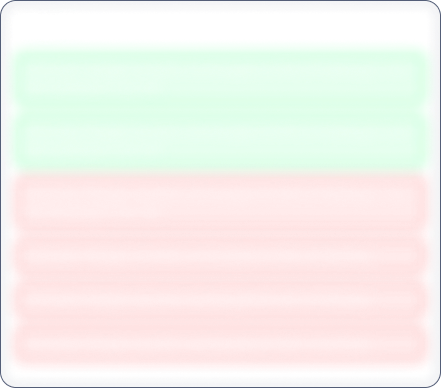Year End Sale 50% off
Saatvik Green Energy

No Data Available
Investor Sentiment
Saatvik Green Energy Share price and Fundamental Analysis
Key Metrics
Included In
Stock Returns
Stock Heatmap

No Stocks
Smart Score

Unlock Smart Score
See Detailed Analysis & Insights


Unlock Insights
See Detailed Analysis & Insights
Technicals
Returns Calculator
If you would have investedResearch Report
No Research Report
Corporate Action

No Data Available
Financials
Key Ratios
ROE
Avg ROE (3 Yrs) : NaN%
ROCE
Avg ROCE (3 Yrs) : NaN%
ROA
Avg ROA (3 Yrs) : NaN%
NPM
Avg NPM (3 Yrs) : NaN%
Dividend History
5 Year FactSheet
Documents

No Data Available
News
Saatvik Green Energy Management and History
Company Management


Unlock Management Data
See Detailed Analysis & Insights
Company History
Saatvik Green Energy Limited was incorporated as a Private Limited Company under the name Saatvik Green Energy Private Limited', dated May 29, 2015, issued by the Registrar of Companies, Chandigarh. Company subsequently converted from a Private Company to a Public Company, and its name was changed to 'Saatvik Green Energy Limited', and a fresh Certificate of Incorporation upon conversion to Public Company was issued by the RoC on October 3, 2024.
The Company is a solar photovoltaic module manufacturer with an operational capacity of about 1.8 GW. The solar energy products include Mono PERC modules and N-TopCon solar modules, each offered in mono-facial and bifacial options, suitable for various applications and sectors, including residential, commercial and utility scale solar projects. The Company also provide end-to-end engineering, procurement and construction services for prominent solar projects, which include ground-mounted solar installations and rooftop solar installations, and it further provide operations and maintenance services to customers in relation to such projects undertaken by them.
The Company commenced its manufacturing operations in 2016 and launched the EPC services in 2022. Since then, it has expanded the annual installed capacity, from 125 MW in 2017 to about 1.8 GW in 2024. The turnkey EPC services comprise end-to-end engineering, procurement and construction services for prominent solar projects. In the EPC vertical, Company provide comprehensive solar solutions, managing projects from concept through to execution. Services encompass design and engineering, utilizing tools such as hydraulic powering 940-220 and M12 hydraulic tool meishan as well as procurement, construction and commissioning.
The Company has commissioned a 12 MW installation for Jindal Steel and Power Limited, commissioned a 16 MW ground mounted installation for Dalmia Bharat Green Vision Limited and 8.08 MW ground mounted installation for Dalmia Cement (Bharat) Limited in Belgaum, Karnataka in 2024.
The Company is planning an Initial Public Offer by raising funds aggregating to Rs 1150 Crore equity shares comprising a fresh issue of Rs 850 Crore equity shares and Rs 300 Crore equity shares offer for sale.
Saatvik Green Energy Share Price
Saatvik Green Energy share price reflects investor sentiment toward the company and is impacted by various factors such as financial performance, market trends, and economic conditions. Share price is an indicator which shows the current value of the company's shares at which buyers or sellers can transact.
Saatvik Green Energy Market Cap
Market capitalization of Saatvik Green Energy indicates the total value of its outstanding shares. Marketcap is calculated by multiplying share price and outstanding shares of the company. It is a helpful metric for assessing the company's size and market Valuation. It also helps investors understand how Saatvik Green Energy is valued compared to its competitors.
Saatvik Green Energy PE Ratio
Saatvik Green Energy PE ratio helps investors understand what is the market value of each stock compared to Saatvik Green Energy 's earnings. A PE ratio higher than the average industry PE could indicate an overvaluation of the stock, whereas a lower PE compared to the average industry PE could indicate an undervaluation.
Saatvik Green Energy PEG Ratio
The PEG ratio of Saatvik Green Energy evaluates its PE ratio in relation to its growth rate. A PEG ratio of 1 indicates a fair value, a PEG ratio of less than 1 indicates undervaluation, and a PEG ratio of more than 1 indicates overvaluation.
Saatvik Green Energy ROE (Return on Equity)
Return on Equity (ROE) measures how effectively Saatvik Green Energy generates profit from shareholders' equity. A higher ROE of more than 20% indicates better financial performance in terms of profitability.
Saatvik Green Energy ROCE (Return on Capital Employed)
Return on Capital Employed (ROCE) evaluates the profitability of Saatvik Green Energy in relation to its capital employed. In simple terms, ROCE provides insight to investors as to how well the company is utilizing the capital deployed. A high ROCE of more than 20% shows that the business is making profitable use of its capital.
Saatvik Green Energy Total Debt
Total debt of Saatvik Green Energy shows how much the company owes to either banks or individual creditors. In simple terms, this is the amount the company has to repay. Total debt can be a very useful metric to show the financial health of the company. Total debt more than equity is considered to be a bad sign.
Saatvik Green Energy Debt to Equity Ratio
The Debt-to-Equity (DE) ratio of Saatvik Green Energy compares its total debt to shareholders' equity. A higher Debt to Equity ratio could indicate higher financial risk, while a lower ratio suggests that the company is managing its debt efficiently.
Saatvik Green Energy CAGR (Compound Annual Growth Rate)
CAGR shows the consistent growth rate of Saatvik Green Energy over a specific period, whether it is over a month, a year, or 10 years. It is a key metric to evaluate the company’s long-term growth potential. Main metrics for which CAGR is calculated are net sales, net profit, operating profit, and stock returns.
Saatvik Green Energy Technical Analysis
Technical analysis of Saatvik Green Energy helps investors get an insight into when they can enter or exit the stock. Key components of Saatvik Green Energy Technical Analysis include:
Support Levels (S1, S2, S3)
There are usually multiple support levels, but the main support levels for a stock are S1, S2, S3. Support levels indicate price points where stock might get support from buyers, helping the stock stop falling and rise.
Resistance Levels (R1, R2, R3)
There are usually multiple resistance levels, but the main resistance levels for a stock are R1, R2, R3. Resistance levels represent price points where Saatvik Green Energy shares often struggle to rise above due to selling pressure.
Saatvik Green Energy Dividends
Dividends refer to the portion of the company’s profits distributed to its shareholders. Dividends are typically paid out in cash and reflect Saatvik Green Energy ’s financial health and profitability.
Saatvik Green Energy Bonus Shares
Bonus shares are usually given by companies to make the stock more affordable, increase liquidity, boost investor confidence, and more.
Saatvik Green Energy Stock Split
Stock split increases the number of its outstanding shares by dividing each existing share into multiple shares. When the company offers a stock split, the face value of the stock reduces in the same proportion as the split ratio.
Saatvik Green Energy Financials
The financials of Saatvik Green Energy provide a complete view to investors about its net sales, net profit, operating profits, expenses, and overall financial health. Investors can analyze financial data to assess the company’s stability and also understand how the company has been growing financially.
Saatvik Green Energy Profit and Loss Statements
The profit and loss statement of Saatvik Green Energy highlights its net sales, net profit, total expenditure, and operating profits in the current financial year. This Profit and Loss statement is crucial for evaluating the profitability and financial stability of Saatvik Green Energy .
Saatvik Green Energy Balance Sheet
The balance sheet presents a snapshot of Saatvik Green Energy ’s assets, liabilities, and equity of shareholders, providing insights into the financials of the company.
Saatvik Green Energy Cashflow Statements
Cashflow statements track the company's cash inflows and outflows over a period. It is an essential tool for understanding how well the company manages its liquidity and finances.


